复旦大学【克鲁格曼《国际经济学》第六版英文课件】CH11
- 格式:ppt
- 大小:105.50 KB
- 文档页数:22
![国际经济学克鲁格曼版[]PPT课件](https://uimg.taocdn.com/90382b676c175f0e7dd1372e.webp)
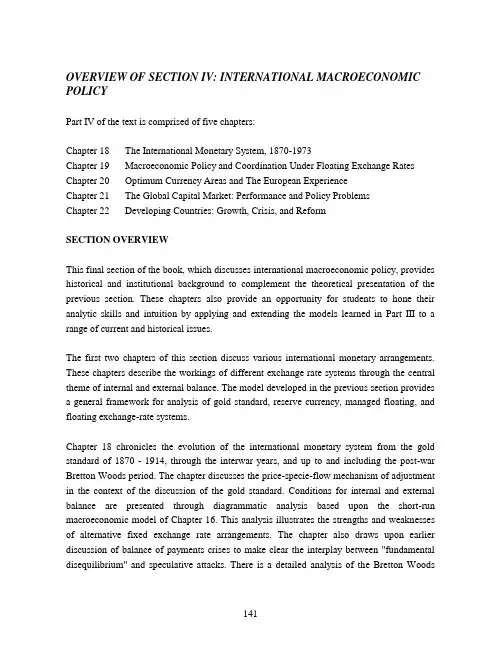
OVERVIEW OF SECTION IV: INTERNATIONAL MACROECONOMIC POLICYPart IV of the text is comprised of five chapters:Chapter 18 The International Monetary System, 1870-1973Chapter 19 Macroeconomic Policy and Coordination Under Floating Exchange Rates Chapter 20 Optimum Currency Areas and The European ExperienceChapter 21 The Global Capital Market: Performance and Policy ProblemsChapter 22 Developing Countries: Growth, Crisis, and ReformSECTION OVERVIEWThis final section of the book, which discusses international macroeconomic policy, provides historical and institutional background to complement the theoretical presentation of the previous section. These chapters also provide an opportunity for students to hone their analytic skills and intuition by applying and extending the models learned in Part III to a range of current and historical issues.The first two chapters of this section discuss various international monetary arrangements. These chapters describe the workings of different exchange rate systems through the central theme of internal and external balance. The model developed in the previous section provides a general framework for analysis of gold standard, reserve currency, managed floating, and floating exchange-rate systems.Chapter 18 chronicles the evolution of the international monetary system from the gold standard of 1870 - 1914, through the interwar years, and up to and including the post-war Bretton Woods period. The chapter discusses the price-specie-flow mechanism of adjustment in the context of the discussion of the gold standard. Conditions for internal and external balance are presented through diagrammatic analysis based upon the short-run macroeconomic model of Chapter 16. This analysis illustrates the strengths and weaknesses of alternative fixed exchange rate arrangements. The chapter also draws upon earlier discussion of balance of payments crises to make clear the interplay between "fundamental disequilibrium" and speculative attacks. There is a detailed analysis of the Bretton Woodssystem that includes a case study of the experience during its decline beginning in the mid-1960s and culminating with its collapse in 1973.Chapter 19 focuses on recent experience under floating exchange rates. The discussion is couched in terms of current debate concerning the advantages of floating versus fixed exchange rate systems. The theoretical arguments for and against floating exchange rates frame two case studies, the first on the experience between the two oil shocks in the 1970s and the second on the experience since 1980. The transmission of monetary and fiscal shocks from one country to another is also considered. Discussion of the experience in the 1980s points out the shift in policy toward greater coordination in the second half of the decade. Discussion of the 1990s focuses on the strong U.S. economy from 1992 on and the extended economic difficulties in Japan. Finally, the chapter considers what has been learned about floating rates since 1973. The appendix illustrates losses arising from uncoordinated international monetary policy using a game theory setup.Europe’s switch to a single currency, the euro, is the subject of Chapter 20, and provides a particular example of a single currency system. The chapter discusses the history of the European Monetary System and its precursors. The early years of the E.M.S. were marked by capital controls and frequent realignments. By the end of the 1980s, however, there was marked inflation convergence among E.M.S. members, few realignments and the removal of capital controls. Despite a speculative crisis in 1992-3, leaders pressed on with plans for the establishment of a single European currency as outlined in the Maastricht Treaty which created Economic and Monetary Union (EMU). The single currency was viewed as an important part of the EC 1992 initiative which called for the free flow within Europe of labor, capital, goods and services. The single currency, the euro, was launched on January 1, 1999 with eleven original participants. These countries have ceded monetary authority to a supranational central bank and constrained their fiscal policy with agreements on convergence criteria and the stability and growth pact. A single currency imposes costs as well as confers benefits. The theory of optimum currency areas suggests conditions which affect the relative benefits of a single currency. The chapter provides a way to frame this analysis using the GG-LL diagram which compares the gains and losses from a single currency. Finally, the chapter examines the prospects of the EU as an optimal currency area compared to the United States and considers the future challenges EMU will face.The international capital market is the subject of Chapter 21. This chapter draws an analogy between the gains from trade arising from international portfolio diversification andinternational goods trade. There is discussion of institutional structures that have arisen to exploit these gains. The chapter discusses the Eurocurrency market, the regulation of offshore banking, and the role of international financial supervisory cooperation. The chapter examines policy issues of financial markets, the policy trilemma of the incompatibility of fixed rates, independent monetary policy, and capital mobility as well as the tension between supporting financial stability and creating a moral hazard when a government intervenes in financial markets. The chapter also considers evidence of how well the international capital market has performed by focusing on issues such as the efficiency of the foreign exchange market and the existence of excess volatility of exchange rates.Chapter 22 discusses issues facing developing countries. The chapter begins by identifying characteristics of the economies of developing countries, characteristics that include undeveloped financial markets, pervasive government involvement, and a dependence on commodity exports. The macroeconomic analysis of previous chapters again provides a framework for analyzing relevant issues, such as inflation in or capital flows to developing countries. Borrowing by developing countries is discussed as an attempt to exploit gains from intertemporal trade and is put in historical perspective. Latin American countries’ problems with inflation and subsequent attempts at reform are detailed. Finally, the East Asian economic miracle is revisited (it is discussed in Chapter 10), and the East Asian financial crisis is examined. This final topic provides an opportunity to discuss possible reforms of the world’s financial architecture.。
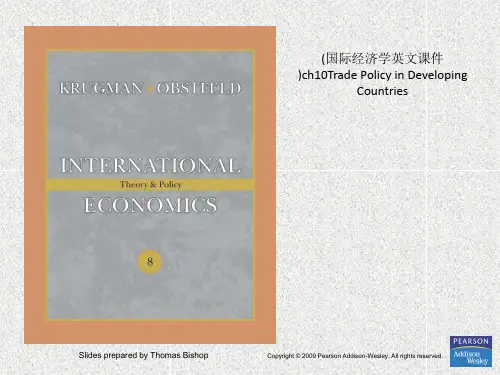
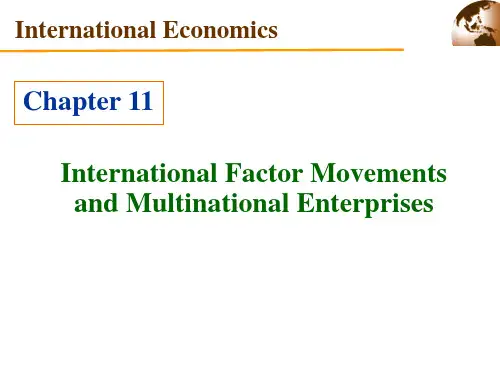
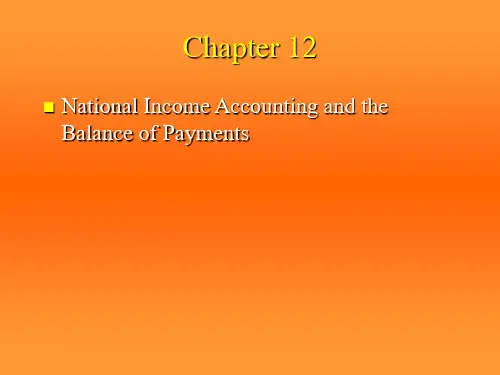
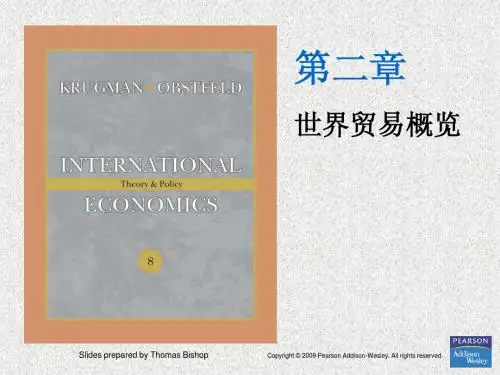

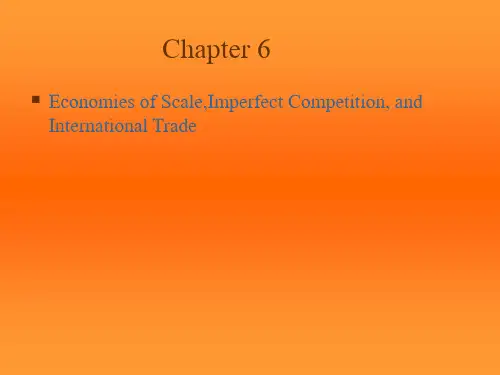

保罗克鲁格曼国际经济学英⽂课件1-7章Preface§1. Some distinctive features of International Economics: Theory and Policy.This book emphasizes several of the newer topics that previous authors failed to treat in a systematic way:·Asset market approach to exchange rate determination.·Increasing returns and market structure.·Politics and theory of trade policy.·International macroeconomic policy coordination·The word capital market and developing countries.·International factor movements.§2. Learning features:·Case studies·Special boxes·Captioned diagrams·Summary and key terms·Problems·Further reading§3.Reference books:·[美]保罗?克鲁格曼,茅瑞斯?奥伯斯法尔德,《国际经济学》,第6版,中译本,中国⼈民⼤学出版社,2007.·李坤望主编,《国际经济学》,第⼆版,⾼等教育出版社,2005.·Dominick Salvatore, International Economics, Prentice Hall International,第9版,清华⼤学出版社,英⽂版,2008. Chapter 1Introduction·Nations are more closely linked through trade in goods and services, through flows of money, and through investment than ever before.§1. What is international economics about?Seven themes recur throughout the study of international economics:·The gains from trade(National welfare and income distribution)·The pattern of trade·Protectionism·The balance of payments·Exchange rate determination·International capital market§2. International economics: trade and money·Part I (chapters 2 through 7) :international trade theory·Part II (chapters 8 through 11) : international trade policy ·Part III (chapters 12 through 17) : international monetary theory ·Part IV (chapters 18 through 22) : international monetary policyChapter 2 World Trade: An Overview§1 Who Trades with Whom?1. Size Matters: The Gravity ModelThe size of an economy is directly related to the volume of imports and exports.Larger economies produce more goods and services, so they have more to sell in the export market. Larger economies generate more income from the goods and services sold, so people are able to buy more imports.3 of the top 10 trading partners with the US in 2003 were also the 3 largest European economies: Germany, UK and France. These countries have the largest gross domestic product (GDP) in Europe.Cultural affinity: if two countries have cultural ties, it is likely that they also have strong economic ties.Geography: ocean harbors and a lack of mountain barriers make transportation and tradeeasier.2. Distance Matters: The Gravity ModelDistance between markets influences transportation costs and therefore the cost of imports and exports. Distance may also influence personal contact and communication, which may influence trade.Estimates of the effect of distance from the gravity model predict that a 1% increase in the distance between countries isassociated with a decrease in the volume of trade of 0.7% to 1%.Borders: crossing borders involves formalities that take time and perhaps monetary costs like tariffs. These implicit and explicit costs reduce trade. The existence of borders may also indicate the existence of different languages or different currencies, either of which may impede trade more.3.The gravity modelThe gravity model is:a b c ij i j ijT A Y Y D =?? where a, b, and c are allowed to differ from 1.§2. The Changing Composition of Trade1. Has the World Become “Smaller ”?There were two waves of globalization.1840–1914: economies relied on steam power, railroads, telegraph, telephones. Globalization was interrupted and reversed by wars and depression.1945–present: economies rely on telephones, airplanes, computers, internet, fiber optics,…2. Changing Composition of TradeToday, most of the volume of trade is in manufactured products such as automobiles, computers, clothing and machinery. Services such as shipping, insurance, legal fees and spending by tourists account for 20% of the volume of trade.Mineral products (e.g., petroleum, coal, copper) and agricultural products are a relatively small part of trade.Multinational Corporations and OutsourcingBefore 1945, multinational corporations played a small role world trade.But today about one third of all US exports and 42% of all US imports are sales from one division of a multinational corporation to another.Chapter 3Labor Productivity and Comparative Advantage:The Ricardian Model*Countries engage in international trade for two basic reasons:·Comparative advantage: countries are different in technology (chapter 3) or resource (chapter 4).·Economics of scale (chapter 6).*All motives are at work in the real world but only one motive is present in each trade model.§1. The concept of comparative advantage1. Opportunity cost : The opportunity cost of roses in terms of computers is the number of computers that could have been produced with the resources used to produce a given number of roses.Table 3-1 Hypothetical Changes in Production Million Roses Thousand Computers United States-10 +100 South America+10 -30 Total 0 +702. Comparative advantage : A country has a comparative advantage in producing a good if the opportunity cost of producing that good in terms of other goods is lower in that country than it is in other countries.·Denoted by opportunity cost.·A relative concept : relative labor productivity or relative abundance.3. The pattern of trade: Trade between two countries can benefit both countries if each country exports the goods in which it has a comparative advantage.§2. A one-factor economy1.production possibilities: LC C LW W a Q a Q L +≤Figure 3-1 Home’s Production Possibility Frontier2. Relative price and supply·Labor will move to the sector which pays higher wage.·If C W LC LW P P a a >(C LC W LW P a P a >, wage in the cheese sector is higher ), the economy will specialize in the production of cheese.·In a closed economy, C W LC LW P P a a =.·If each country has absolute advantage in one good respectively, will there exist comparative advantage?§3. Trade in a one-factor world·Model : 2×1×2·Assume: **LC LW LC LW a a a a <Home has a comparative advantage in cheese.Home ’s relative productivity in cheese is higher.Home ’s pretrade relative price of cheese is lower than foreign.·The condition under which home has the comparative advantage involves all four unit labor requirement, not just two.1. Determining the relative price after trade·Relative price is more important than absolute price, when people make decisions on production and consumption.·General equilibrium analysis: RS equals RD . (World general equilibrium)·RS : a “step ” with flat sections linked by a vertical section. **(/)(/)LC LW L a L aFigure 3-3 World Relative Supply and Demand·RD : subsititution effects·Relative price after trade: between the two countries ’ pretrade price.(How will the size of the trading countries affect the relative price after trade? Which country ’s living condition improves more? Is it possible that a country produce both goods?)2. The gains from tradeThe mutual gain can be demonstrated in two alternative ways.·To think of trade as an indirect method of production :(1/)()1/LC C W LW a P P a > or C W LC LW P P a a >·To examine how trade affects each country ’s possibilities of consumption.Figure 3-4 Trade Expands Consumption Possibilities(How will the terms of trade change in the long-term? Are there income distribution effects within countries? )3. A numerical example:·Two crucial points :When two countries specialize in producing the goods in which they have a comparative advantage, both countries gain from trade.Comparative advantage must not be confused with absolute advantage; it is comparative, not absolute, advantage that determines who will and should produce a good.Table 3-2 Unit Labor Requirements Cheese WineHome 1LC a = hour per pound 2LW a = hours per gallonForeign*6LC a = hours per pound *3LW a = hours per gallon absolute advantage; relative price; specialization; the gains from trade.4. Relative wages·It is precisely because the relative wage is between the relative productivities that each country ends up with a cost advantage in one good.***LC LC LW LW a a w w a a >> **LC LC wa w a <;**LW LW wa w a >·Relative wages depend on relative productivity and relative demand on goods.Special box: Do wages reflect productivity?。
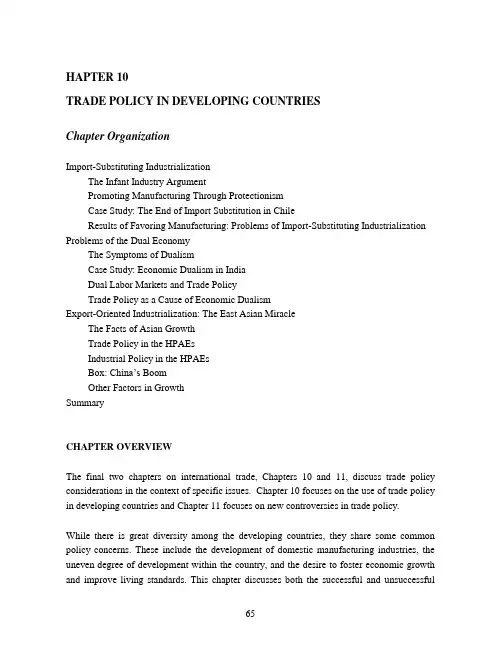
HAPTER 10TRADE POLICY IN DEVELOPING COUNTRIESChapter OrganizationImport-Substituting IndustrializationThe Infant Industry ArgumentPromoting Manufacturing Through ProtectionismCase Study: The End of Import Substitution in ChileResults of Favoring Manufacturing: Problems of Import-Substituting Industrialization Problems of the Dual EconomyThe Symptoms of DualismCase Study: Economic Dualism in IndiaDual Labor Markets and Trade PolicyTrade Policy as a Cause of Economic DualismExport-Oriented Industrialization: The East Asian MiracleThe Facts of Asian GrowthTrade Policy in the HPAEsIndustrial Policy in the HPAEsBox: China’s BoomOther Factors in GrowthSummaryCHAPTER OVERVIEWThe final two chapters on international trade, Chapters 10 and 11, discuss trade policy considerations in the context of specific issues. Chapter 10 focuses on the use of trade policy in developing countries and Chapter 11 focuses on new controversies in trade policy.While there is great diversity among the developing countries, they share some common policy concerns. These include the development of domestic manufacturing industries, the uneven degree of development within the country, and the desire to foster economic growth and improve livingstandards. This chapter discusses both the successful and unsuccessful trade policy strategies which have been applied by developing countries in attempts to address these concerns.Many developing countries pose the creation of a significant manufacturing sector as a key goal of economic development. One commonly voiced argument for protecting manufacturing industries is the infant industry argument, which states that developing countries have a potential comparative advantage in manufacturing and can realize that potential through an initial period of protection. This argument assumes market failure in the form of imperfect capital markets or the existence of externalities in production: such a market failure makes the social return to production higher than the private return. This implies that a firm will not be able to recapture rents or profits that are in line with the contribution to welfare made by the product or industry establishment of the firm. Without some government support, the argument goes, the amount of investment which will occur in this industry will be less than socially optimal levels.Given these arguments, many nations have attempted import substitution led industrialization. In the 1950s and 1960s the strategy was quite popular and did lead to a dramatic reduction in imports in some countries. The overall result, though, was not a success. The infant industry argument did not always hold, as protection could let young industries survive, but could not make them efficient. By the late 1980s, most countries had shifted away from the strategy, and the chapter includes a case study of Chile’s change from import substitution to a more open strategy.Development often proceeds unevenly and results in a dual economy consisting of a modern sector and a traditional sector. The modern sector typically differs from the traditional sector in that it has a higher value of output per worker, higher wages, higher capital intensity, lower returns to capital, and persistent unemployment. For example, in India less than one percent of the population is employed in the manufacturing sector but this sector produces 15 percent of GNP. Wages in Indian manufacturing are six times those in agriculture.Some argue that the existence of wage differentials in a dual economy demonstrate the failure of labor markets to work well. Society would benefit if workers moved from agriculture to manufacturing. A first best policy addresses the wage differential directly. Protectionism may be a second best solution, but one with the undesirable consequences of inducing both capital and labor into manufacturing. This raises the already too high capital intensity in the manufacturing sector. Further, an increase in the number of urban manufacturing jobs may exacerbate the problems of urban unemployment through migration from the countryside to the cities. This is a key theme of theHarris-Todaro model. Thus, it is possible that the medicine of trade policies worsens the illness of dualism.The East Asian “miracle” of the high-performing Asian economies (HPAEs) provides a striking and controversial example of export-oriented industrialization. While these countries encountered difficulties in the late 1990s (see Chapter 22), this chapter focuses on their spectacular growth from the 1960s to 1990s. It is acknowledged that the growth was extremely impressive; the controversy is over the source of the success in these countries. Some observers argue that although these countries do not practice free trade, they have lower rates of protection (and more outward orientation) than other developing countries. Other observers argue that the interventionist industrial policies pursued by the HPAEs have been the reason for success, and outward orientation is just a by-product of active rather than passive government involvement in industry. Still others argue that high rates of domestic savings and rapid improvements in education are behind the stunning growth performance.ANSWERS TO TEXTBOOK PROBLEMS1. The Japanese example gives pause to those who believe that protectionism is alwaysdisastrous. However, the fact of Japanese success does not demonstrate that protectionist trade policy was responsible for that success. Japan was an exceptional society that had emerged into the ranks of advanced nations before World War II, and was recovering from wartime devastation. It is arguable that economic success would have come anyway, so that the apparent success of protection represents a "pseudo-infant-industry" case of the kind discussed in the text.2. a. The initial high costs of production would justify infant industry protection if the costs to thesociety during the period of protection were less than the future stream of benefits from a mature, low cost industry.b. An individual firm does not have an incentive to bear development costs itself for an entireindustry when these benefits will accrue to other firms. There is a stronger case for infant industry protection in this instance because of the existence of market failure in the form of the appropriability of technology.3. There are larger markets in larger countries like Brazil and industries which benefit fromimport substituting policies could realize economy of scale advantages there which would not be available to industries producing solely for the market of Ghana.4. The value of the marginal product of labor in the production of food is 9 x $10 = $90.a. The wage will be equated in each sector when there are no distortions. This occurs whenthere are 8 workers in manufacturing and 12 in food production. The wage of all workers will be $90. The output of each sector can be found by calculating the area under the marginal product of labor curves. This curve is a horizontal line for food, so output in this sector is 12 x 9 = 108. Summing the area under the MPL curve for manufacturing up to 8 workers results in output of 110.b. Manufacturing output shrinks to 3 workers, and there are 17 workers in the food sector.Food output now equals 153 while manufacturing output equals 54. The cost of the distortion equals the value of output lost, which is $110.c. The probability of being employed is 1 - (n+3/n) = 3/n where n is the number of city workers.Workers will migrate to the city until the wage times the probability of being employed equals the wage offered in the rural area with certainty. There will be 5 workers in manufacturing,15 workers in agriculture, and 2 unemployed workers. The output of the manufacturingsector is 54 and for food is 135.5. Under these circumstances, workers are both "pulled" into the urban, "modern" sector by thelure of high wages and "pushed" from the rural areas due to stagnant conditions in the agricultural sector. To correct this problem of the bias toward the urban-manufacturing sector, explicit attention should be paid to making the agricultural sector more rewarding, In order to retain labor, the agricultural sector might be provided with wage subsidies so that the rural-urban wage gap is reduced. Policies can also be targeted at promoting light rural enterprise and agricultural investment which would increase wages through increasing worker productivity. In addition, development of the rural infrastructure and social services might increase the relative attractiveness of the countryside.6. Import quotas on capital-intensive goods and subsidies for the import of capital equipmentfoster the development of a capital intensive sector, and thus of a dual economy. If the capital-intensive sector pays high wages relative to the traditional sector, the result may be rural-urban migration and the emergence of persistent urban unemployment.FURTHER READINGSJagdish Bhagwati, ed.. The New International Economic Order. Cambridge: MIT Press, 1977.Jagdish Bhagwati and T.N. Srinivasan. "Trade Policy and Development," in Rudiger Dornbusch and Jacob A. Frenkel, eds.. International Economic Policy: Theory and Evidence. Baltimore: Johns Hopkins University Press, 1979, pp. 1-35.W.M. Corden. Trade Policy and Economic Welfare. Oxford: Clarendon Press, 1974.Anne O. Krueger, "Trade Policies in Developing Countries," in Ronald W. Jones and Peter B. Kenen, eds.. Handbook of International Economics. Vol. 1. Amsterdam: North-Holland, 1984. W. Arthur Lewis. The Theory of Economic Development. Homewood, Illinois: Irwin, 1955.I.M.D. Little. Economic Development. New York: Basic Books, 1982.I.M.D. Little, Tibor Scitovsky, and Maurice Scott. Industry and Trade in Some Developing Countries. New York: Oxford University Press, 1970.Dani Rodrik. "Imperfect Competition, Scale Economies and Trade Policies in Developing Countries", in Robert E. Baldwin, ed.. Trade Policy Issues and Empirical Analysis. Chicago: Univ. of Chicago Press, 1988.World Bank. The East Asian Miracle: Economic Growth and Public Policy. Oxford: Oxford University Press, 1993.World Bank. World Development Report 1991: The Challenge of Development. Washington, D.C.: World Bank, 1991.Alwyn Young. “A Tale of Two Cities: Factor Accumulation and Technical Change in Hong Kong and Singapore”, in O.J. Blanchard and S. Fischer, eds. NBER Macroeconomics Annual 1992.. Alwyn Young. “The Tyranny of Numbers: Confronting the Statistical Realities of the East Asian Growth Experience,” Quarterly Journal of Economics 101 (August 1994) pp.641-80.。
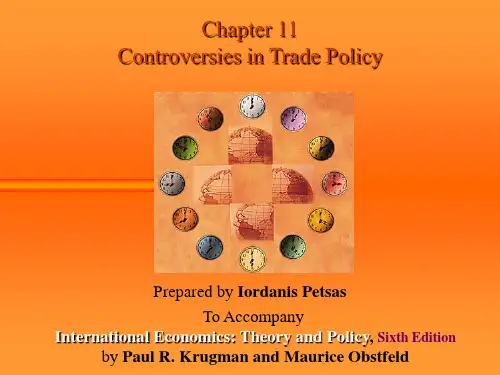
OVERVIEW OF SECTION II: INTERNATIONAL TRADE POLICYSection II of the text is comprised of four chapters:Chapter 8 The Instruments of Trade PolicyChapter 9 The Political Economy of Trade PolicyChapter 10 Trade Policy in Developing CountriesChapter 11 Strategic Trade Policies in Advanced CountriesSECTION II OVERVIEWTrade policy issues figure prominently in current political debates and public policy discussions. The first two chapters of this section of the text are concerned with the instruments of trade policy and the arguments for free trade and managed trade. The second two chapters consider these concepts in the context of specific sets of countries that face common problems. Throughout, the use of case studies provides the student with real world examples that clearly illustrate the theoretical arguments.Chapter 8 discusses various instruments of trade policy including tariffs, quotas, voluntary export restraints, and local content requirements. The effects of these policies on prices and trade volumes are determined in the context of a partial equilibrium framework. The chapter reviews the analytical tools of consumer and producer surplus, and uses these tools to consider the welfare effects of various protectionist measures. The specific incidents of trade restrictions presented as case studies include import quotas on sugar entering United States markets, voluntary export restraints on Japanese autos, and oil import quotas.Chapter 9 presents the set of ideas known as the political economy of trade theory. These ideas enable you to understand why certain trade restrictions exist, despite the force of general economic arguments which suggest that they reduce aggregate welfare. Possible motivations for trade restrictions are identified as those which increase national welfare, such as the optimum tariff, and those which foster either income redistribution or the preservation of status quo. While sometimes politically popular, these motivations for trade restrictions ignore the possibility of retaliation and usually fail tests based upon basic welfare analysis. Trade agreements of the 1990s are discussed, including the Uruguay Round, and distinctionsare made between Free Trade Areas and Customs Unions as well as between trade creation and trade diversion.Chapter 10 considers the possible uses of trade policies to promote the growth of developing economies. The chapter reviews the relative successes of different development strategies. It examines arguments for and the results of import-substituting industrialization. The phenomenon of economic dualism, referring to the coexistence of capital intensive industrial sectors and low-wage traditional sectors, and of uneven development are considered. The chapter concludes with a discussion of export led growth and the experience of the high performing Asian economies.Chapter 11 considers recent controversies in trade policy. The first part of the chapter considers the notion of strategic trade policy, which first arose in the 1990s. Strategic trade policy refers to the use of trade (and other) tools for channeling resources to sectors targeted for growth by industrial country governments. The chapter presents some commonly voiced arguments for intervention in particular sectors of the economy, and then shows how these arguments are critically flawed. The second part of the chapter introduces more sophisticated arguments for strategic trade policy. The most persuasive of these is the existence of some form of market failure. The second part of the chapter considers the impact of rising trade on workers in developing countries, and more broadly, the debate over globalization. This debate has been argued in academia and policy circles, but also on the streets of Seattle, Genoa, and other cities hosting global economic summits.。
MATHEMATICAL POSTSCRIPTThese postscripts set out formal mathematical treatments of models presented in earlier chapters. The level of mathematical sophistication is a step above that used in the text; calculus and maximization principles are employed. A prior knowledge of these tools, however, is not necessary for students to work through these postscripts since there is an intuitive explanation of derivatives and maximization.The postscript to Chapter 3 uses the "hat algebra" technique to present the specific factors model. Factor price determination and the effects of a change in relative prices are derived formally. The postscript to Chapter 4 presents a formal treatment of the factor proportions model, again using "hat algebra", to derive the relationship between goods prices and factor prices and to demonstrate the relationship between factor supplies and output. The postscript to Chapter 5 develops a formal presentation of the standard trade model. This presentation, which introduces a utility function, derives the world trading equilibrium, demonstrates its stability, and investigates the effects of economic growth, the transfer problem, and the effects of a tariff using comparative statics analysis.The postscript to Chapter 21 develops a model of international portfolio diversification by a risk-averse investor. Both an analytic and a diagrammatic derivation of the investor's choice of the optimal portfolio is presented. The diagram which is developed is employed to consider the effects of changing rates of return on the investor's choice.。